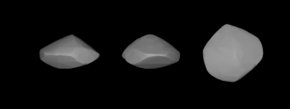 A three-dimensional model of 683 Lanzia based on its light curve | |
| Discovery | |
|---|---|
| Discovered by | Max Wolf |
| Discovery site | Heidelberg |
| Discovery date | 23 July 1909 |
| Designations | |
| (683) Lanzia | |
| 1909 HC | |
| Orbital characteristics [1] | |
| Epoch 31 July 2016 ( JD 2457600.5) | |
| Uncertainty parameter 0 | |
| Observation arc | 101.75 yr (37,164 d) |
| Aphelion | 3.2891 AU (492.04 Gm) |
| Perihelion | 2.9402 AU (439.85 Gm) |
| 3.1146 AU (465.94 Gm) | |
| Eccentricity | 0.056013 |
| 5.50 yr (2007.7 d) | |
| 278.966 ° | |
| 0° 10m 45.516s / day | |
| Inclination | 18.509° |
| 259.724° | |
| 283.703° | |
| Physical characteristics | |
Mean radius | 41.52±11.1 km |
| 8.630 h (0.3596 d) | |
| 0.1474±0.128 | |
| 8.7 | |
683 Lanzia is a minor planet orbiting the Sun. It was discovered July 23, 1909, by Max Wolf at the Landessternwarte Heidelberg-Königstuhl observatory [2] and was named in honor of Lanz, founder of the Heidelberg Academy of Sciences. Photometric observations made in 2003 at the Santana Observatory in Rancho Cucamonga, California, give a synodic rotation period of 8.63 ± 0.005 hours. The light curve shows a brightness variation of 0.15 ± 0.04 in magnitude. [2]
Observations during two last occultation 18 and 22 December 2010 (P.Baruffetti, G. Tonlorenzi - Massa, G. Bonatti - Carrara, R. Di Luca - Bologna (Italy), C. Schnabel - S. Estebe, J. Rovira - Moja (Spain)) measured a 122.5 km diameter (medium) and an Albedo of 0.0705 compatible with carbonaceous asteroids (C group).
References
- ^ "683 Lanzia (1909 HC)". JPL Small-Body Database. NASA/ Jet Propulsion Laboratory. Retrieved 5 May 2016.
- ^ a b Stephens, Robert D. (March 2004), "Photometry of 683 Lanzia, 1101 Clematis, 1499 Pori, 1507 Vaasa, and 3893 DeLaeter", The Minor Planet Bulletin, vol. 31, no. 1, pp. 4–6, Bibcode: 2004MPBu...31....4S.
External links
- 683 Lanzia at AstDyS-2, Asteroids—Dynamic Site
- 683 Lanzia at the JPL Small-Body Database